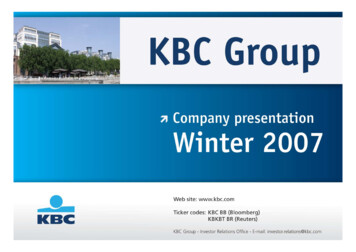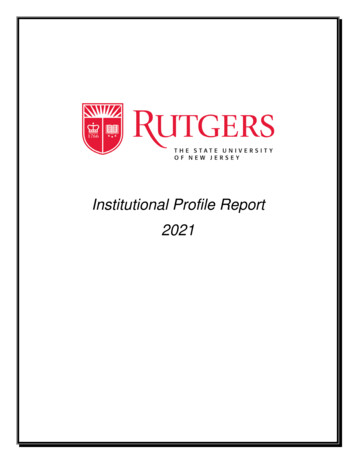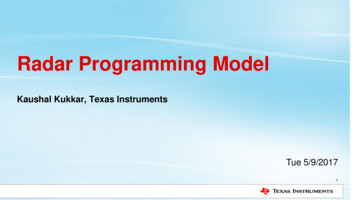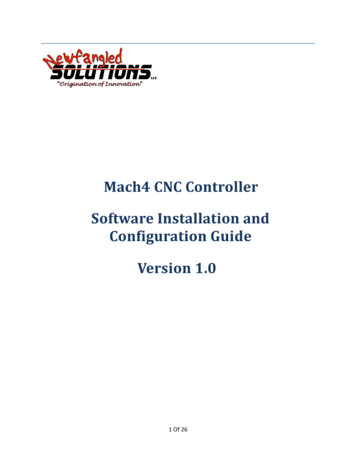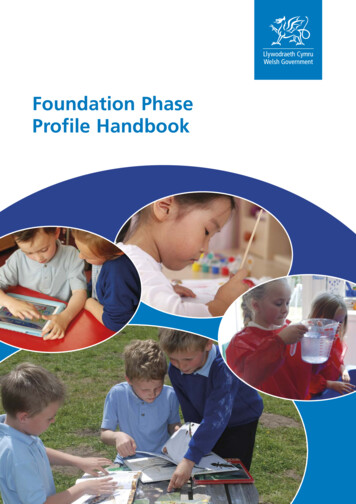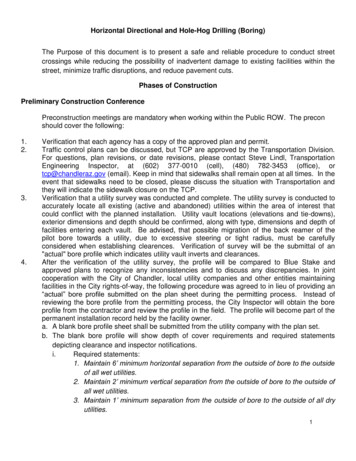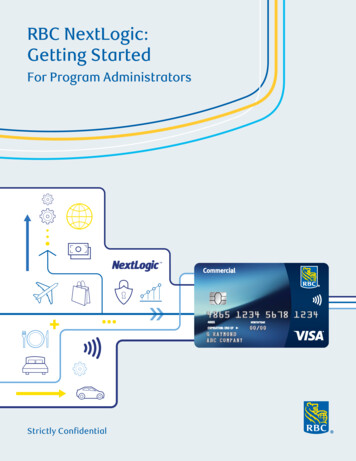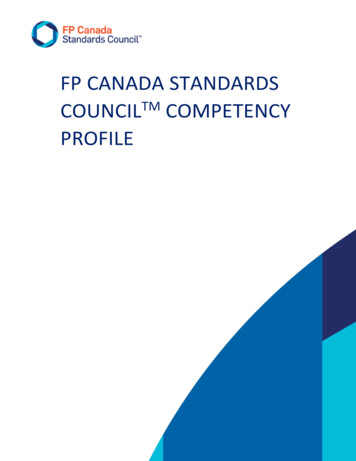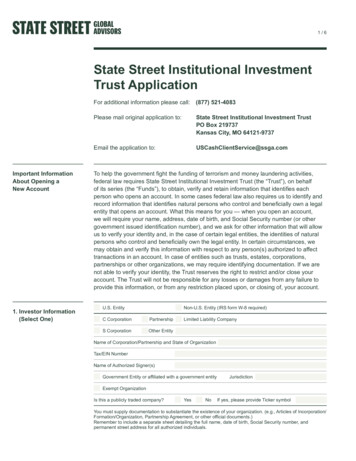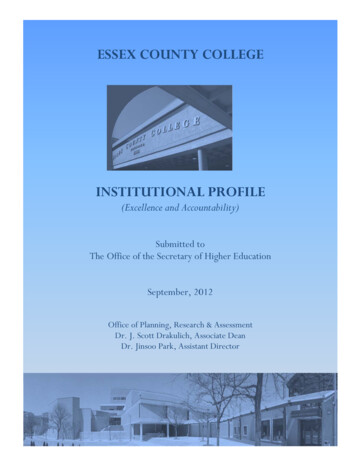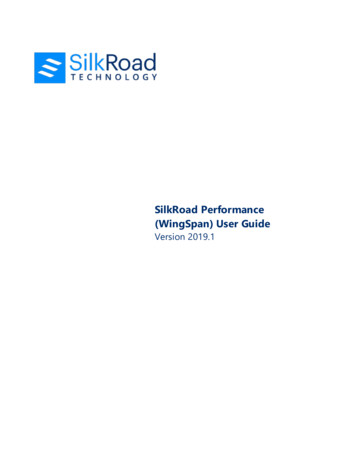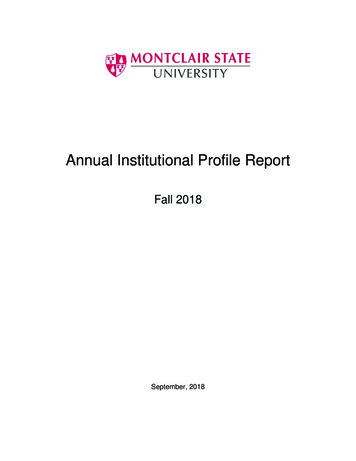
Transcription
Annual Institutional Profile ReportFall 2018September, 2018
Annual Institutional Profile of Montclair State University, 2018PREFACEFounded as the New Jersey State Normal School at Montclair in 1908, Montclair State Universitytoday is a preeminent center of research, education and scholarship. The University offers a broadarray of undergraduate and graduate programs in the liberal arts and sciences, as well as in theprofessional fields of business, the arts and education. Substantial growth in research activity anddoctoral-level education has earned Montclair State designation by the State of New Jersey as apublic research university, and by the Carnegie Classification of Institutions of Higher Education asa national research doctoral university.Montclair State is currently in a period of significant growth and development with an enrollment of21,000 students, new programs, new faculty and expanding physical facilities. Recentaccomplishments include the opening of a new Center for Computing and Information Science, thefounding of the new University College, the opening and expansion of the School of Nursing, andconstruction of state-of-the-art learning and research facilities for students in the Feliciano School ofBusiness, College of Science and Mathematics, The Graduate School, School of Nursing, and Schoolof Communication and Media. The University received the largest philanthropic gift in its history — 20 million to support the Feliciano School of Business — and met the Federal criteria forrecognition as an Hispanic-Serving Institution. These activities are evidence of the University’scommitment to steadily adapting and evolving to serve the educational needs of New Jersey,grounded in a mission of academic excellence and service. The University’s full mission statementfollows.Institutional MissionMontclair State University is committed to serving the educational needs of New Jersey withprograms characterized by academic rigor and currency in the development of knowledge and itsapplications. The University will offer a comprehensive range of baccalaureate, master’s andcertificate programs and a focused portfolio of doctoral programs that are closely aligned with theUniversity’s academic strengths and the needs of the state.The University will recruit faculty with exceptional academic or professional credentials and a deepcommitment to the pursuit of their development as teachers and scholars. The University will admitto study with this faculty, students who have demonstrated the potential for high achievement,diligence in the pursuit of their education, and high aspirations for using their education. TheUniversity will be inexorably committed to the maintenance of a learning community that is deeplyand broadly reflective of the diverse population of New Jersey.All University programs will develop in students the ability to discover, create, evaluate, apply, andshare knowledge in a climate characterized by tolerance and openness in the exploration of ideas.Curricular and co-curricular programs will cultivate the ability to think critically, to act ethically, andto become informed citizen-participants prepared to assume leadership roles in a democracy.i
Annual Institutional Profile of Montclair State University, 2018Recognizing the increasing connectedness of the world, the University will ensure that all studentsdevelop an understanding of global issues and of their responsibilities as citizens of the world.The University will serve as a center for the creation of new knowledge and for the development ofinnovative applications of existing knowledge and as a center for pedagogical and artistic excellenceand creativity. The University seeks to focus the professional activities of its faculty and theeducational endeavors of its students on the enduring disciplines that will continue to constitute theknowledge base of an educated citizenry in the 21st century, as well as on the more specific andchanging areas of study that have particular relevance to the region served by the University.The University will play a role beyond the campus community, partnering and collaborating at thelocal, state, national and international levels to make positive contributions to addressing issues ofimportance to society, to enable students to experience their ability to use knowledge in constructiveways in the world, and to share the rich array of intellectual and cultural resources of the Universitywith the people of New Jersey.Dr. Susan A. ColePresidentMontclair State Universityii
Annual Institutional Profile of Montclair State University, 2018I. TABLE OF CONTENTSII. Data by Category . 1SECTION A: Accreditation Status . 1SECTION B: Number of Students Served . 4SECTION C: Characteristics of Undergraduate Students . 5SECTION D: Student Outcomes . 11SECTION E: Faculty Characteristics . 14SECTION F: Characteristics of the Trustees. 16SECTION G: A Profile of the Institution . 17SECTION H: Major Research and Public Service Activities. 22SECTION I: Major Capital Projects. 24APPENDIX 1: University Authorsiii
Annual Institutional Profile of Montclair State University, 2018II. DATA BY CATEGORYA. Accreditation StatusMontclair State University is accredited by the Middle States Commission on Higher Education,3624 Market Street, 2nd Floor West, Philadelphia, PA 19104. Programs leading to a degree orcertificate (not certification) are approved by the Office of the Secretary of Higher Education of theState of New Jersey. Programs leading to NJ State certification are approved by the New JerseyDepartment of Education using the standards of the National Association of State Directors ofTeacher Education and Certification.Discipline-specific accreditations include: AACSB International The Association to Advance Collegiate Schools of Business (Baccalaureateand Graduate degree programs in business, School of Business) ACEND - Accreditation Council for Education in Nutrition and Dietetics of the Academy ofNutrition and Dietetics (Didactic Program in Dietetics, Baccalaureate level; Dietetic Internship,Department of Health and Nutrition Sciences) CAATE - Commission on Accreditation of Athletic Training Education (Athletic Training major,BS, Department of Exercise Science and Physical Education, College of Education and HumanServices) CAC/ABET - Computing Accreditation Commission of the Accreditation Board for Engineeringand Technology (ABET) (Computer Science major, concentration in Professional Computing, BS,Department of Computer Science, College of Science and Mathematics) CACREP - Council for the Accreditation of Counseling and Related Education Programs(Counseling, Ph.D., Counseling, M.A., Department of Counseling and Educational Leadership,College of Education and Human Services) CAA/ASHA - Council on Academic Accreditation in Audiology and Speech-Language Pathologyof the American Speech Language Hearing Association (ASHA). CAA has accredited the M.A. withconcentration in Speech-Language Pathology; and the Doctoral program in Audiology (AuD) in theDepartment of Communication Sciences and Disorders, College of Humanities and Social Sciences CAEP – Council for the Accreditation of Educator Preparation [Formerly NCATE] forprograms preparing elementary and secondary school teachers, as well as administrative and schoolservice personnel CEPH - Council on Education for Public Health. (Master of Public Health (MPH), BS in PublicHealth, concentration in Community Health Education, Department of Public Health, College ofEducation and Human Services1
Annual Institutional Profile of Montclair State University, 2018 NASAD - National Association of Schools of Art and Design (Fashion Studies major, BA; FineArts major, concentrations in Art Education, Art History, Studio Art, BA; Animation/Illustrationmajor, Filmmaking major, Fine Arts/Studio major, Graphic Design major, Industrial Design major,BFA; Studio Art major, MFA; Department of Art and Design, College of the Arts) NASD - National Association of Schools of Dance (Dance major, concentration DanceEducation, BA; Dance major, BFA, Department of Theatre and Dance, College of the Arts) NASM - National Association of Schools of Music (Music Therapy major, BA; Music major,concentrations in Music Education, Jazz Studies, Performance, Theory/Composition, BMus; Musicmajor, concentrations in Music Education, Music Therapy, Performance, and Theory/Composition,MA, John J. Cali School of Music, College of the Arts) NAST - National Association of Schools of Theatre (Theatre Studies major, BA; Theatre majorconcentrations in Acting and in Production/Design, BFA; Theatre major with concentration in ArtsTheatre Studies, MA, Department of Theatre and Dance, School of the Arts)Program approvals include: American Alliance for Health, Physical Education, Recreation, and Dance(AAHPERD)/American Association for Health Education (AAHE): Health Educationmajor, BS, initial teacher certification, P-12American Alliance for Health, Physical Education, Recreation and Dance(AAHPERD)/National Association for Sport and Physical Education (NASPE): PhysicalEducation major, BS, initial teacher certification, P-12American Bar Association: Justice Studies major, Paralegal Studies concentration, BA.Paralegal Studies minor; Post-baccalaureate Certificate Program in Paralegal StudiesAmerican Chemical Society: Biochemistry major, BS; Chemistry major, BS. Chemistryminor; Chemistry major, MS; Chemistry major, Biochemistry concentration, MSAmerican Music Therapy Association: Music Therapy major, BA; Music major,concentration in Music Therapy, MACouncil for Exceptional Children: Early Childhood Special Education major, MEd; LearningDisabilities major, MEd; Learning Disabilities Teacher-Consultant, post-master’scertification; Communication Sciences and Disorders major, concentration in SpeechLanguage Pathology, MAEducational Leadership Constituent Council (ELCC): Educational Leadership major, MAInternational Reading Association (IRA): Reading major, MA; Reading Specialist, postbaccalaureate educational services certification, P-12National Association for the Education of Young Children (NAEYC): Family and ChildStudies major, concentration in Early Childhood, BA, initial teacher certification, P-3National Association for Music Therapy: Music Therapy major, BANational Council for the Social Studies (NCSS): Anthropology major, BA, initial teachercertification, P-12; History major, BA, initial teacher certification, P-12; Political Sciencemajor, BA, initial teacher certification, P-12; Sociology major, BA, initial teacher certification,P-12; Geography major, BA, initial teacher certification, P-12; Economics major, BA, initialteacher certification, P-12; Social Studies, MAT, initial teacher certification, P-12; SocialStudies, post-baccalaureate teacher certification, P-122
Annual Institutional Profile of Montclair State University, 2018 National Council of Teachers of English (NCTE): English major, BA, initial teachercertification, 6-12; English, MAT, initial teacher certification, 6-12; English, postbaccalaureate teacher certification, 6-12National Council of Teachers of Mathematics (NCTM): Mathematics major (BS), initialteacher certification, 6-12; Mathematics, MAT, initial teacher certification, 6-12;Mathematics, post-baccalaureate teacher certification, 6-12Teachers of English to Speakers of Other Languages (TESOL): Linguistics major BA, initialteacher certification, P-12; Teaching English as a Second Language, MAT, initial teachercertification, P-12; Teaching English as a Second Language, post-baccalaureate teachercertification, P-12Memberships include: The Association to Advance Collegiate Schools of BusinessAmerican Association for Paralegal EducationAmerican Association for Colleges for Teacher EducationAmerican Association of Collegiate Registrar’s and Admissions OfficersAmerican Association of State Colleges and UniversitiesAmerican Council on EducationAssociation for Gerontology in Higher EducationAssociation of American Colleges and UniversitiesCouncil of Graduate SchoolsMiddle Atlantic Association of Colleges of Business AdministrationNational Association of Graduate Admissions ProfessionalsNational Association of State Universities and Land-Grant CollegesNational Association of Student Personnel AdministratorsNational Network for Educational RenewalNew Jersey Association of Colleges for Teacher EducationNew Jersey Association of State Colleges and UniversitiesNorth American Association of Summer SessionsNortheastern Association of Graduate Schools3
Annual Institutional Profile of Montclair State University, 2018B. Number of Students ServedFall 2017 UndergraduatesIn fall 2017, 16,852 undergraduates enrolled at Montclair State University (see Table II.B.1). Thisheadcount was up 29.5% from fall 2007, and up 0.2% from fall 2016.Table II.B.1: Undergraduate Enrollment by Attendance Status, Fall 811.3%Total16,852100.0%The proportion of undergraduates studying full-time rose 5.1 percentage points between 2007 and2017, from 83.6% in fall 2007 to 88.7% in fall 2017.Fall 2017 Graduate StudentsMontclair State University enrolled 4,161 graduate students in fall 2017 (see Table II.B.2). Thisgraduate student headcount was up 11.9% from fall 2007, but down -0.4% from fall 2016.Full-timePart-timeTotalTable II.B.2: Graduate Enrollment by Attendance Status, Fall e proportion of graduate students studying full-time has risen over the past decade. The percentof graduate students enrolled full-time rose 15.1 percentage points, from 20.4% in fall 2007 to35.5% in fall 2017.FY17 (12-Month) Unduplicated EnrollmentsWhile most students are admitted and enroll at the beginning of each academic year, thousands ofadditional students enroll during the University’s other sessions that run in the winter, spring, andsummer. During FY17, nearly 24,000 students attended MSU during one or more of its academicsessions (see Table II.B.4).Table II.B.4: Unduplicated Enrollment, FY17 (IPEDS 12-Month)HeadcountCredit 15263,7032,654Professional Practice521,64469Total23,989546,34618,7564
Annual Institutional Profile of Montclair State University, 2018C. Characteristics of Undergraduate StudentsFall 2017 First-time UndergraduatesA total of 13,384 individuals applied for admission as first-time undergraduates to Montclair StateUniversity in fall 2017, up 32% from fall 2007. The University admitted 70.7% of these applicants,and 3,017 of those who were admitted to the University enrolled as first-time undergraduates for ayield of 31.9%. The fall 2017 acceptance rate was 13.7 percentage points higher than in fall 2007,admissions yield was -4.6 percentage points lower than in fall 2007.Fall 2017 first-time undergraduates entered MSU as either regular admits, special admits, or studentsadmitted through the Educational Opportunity Fund (EOF) program. By admitting students usingdifferent admissions categories, the University fulfilled the hopes and aspirations of more of itsapplicants. Of MSU’s 3,017 first-time undergraduates, 94.5% were Regular Admits, 4.1% wereadmitted through the EOF program, and 1.4% were Special Admits (see Table II.C.1).In fall 2015, Montclair State became the first public university in New Jersey to adopt an ACT/SATtest optional policy. The decision was based upon studies showing that SAT and ACT test scoreswere less effective predictors of college success than student performance in high school courses.Test scores are considered if students voluntarily choose to submit them, but applicants are neitherhindered nor advantaged by standardized test scores alone.Montclair State’s test optional policy is designed to ensure that students selected for admission arecapable of succeeding in the University’s rigorous academic programs. It also supports theUniversity’s mission to serve a student body that reflects New Jersey’s socio-economic and ethnicdiversity.A total of 1,205 (39.9%) of MSU’s first-time undergraduates voluntarily submitted SAT scores to theUniversity. Table II.C.1 contains information on SAT scores that were submitted voluntarily by firsttime undergraduates who entered the University as freshmen.TABLE II.C.1: Mean Math, Reading & Writing SAT for First-Time Freshmen,by Admission Status and Overall, Fall 9752953950823449435--Missing1,794------18------5
Annual Institutional Profile of Montclair State University, 2018In fall 2017, Montclair State University did not offer any remedial courses.Table II.C.2: Enrollment in Remedial Courses, Fall 2017Number of StudentsEnrolled in One or MoreRemedial Courses0Percent of Total0.0%Total Number of Full-time,First-time Students3,004Number of FTFT StudentsEnrolled in One or MoreRemedial Courses0Percent of FTFT StudentsEnrolled in One or MoreRemedial Course0.0%Remedial Subject AreaReadingWritingMath ComputationElementary AlgebraNumber of FTFT StudentsEnrolled in0000Percent of FTFT StudentsEnrolled in0.0%0.0%0.0%0.0%Total Fall 2017 UndergraduateEnrollment16,852A CIRP survey administered to fall 2016 first-time undergraduates revealed that over 88%considered MSU to be their first or second choice among colleges. The survey also revealed that thetop four reasons freshmen chose MSU were: a) very good academic reputation (59%), b) goodreputation for social and extracurricular activities (54%), c) affordability (49%), and d) a visit to thecampus (49%). The Freshman Survey (CIRP) is run every three years, and will next be administeredto first-time undergraduates in fall 2019.The profile of the fall 2017 entering class reflects the continuing commitment of the University to anethnically and racially diverse student body. Excluding unknowns, 17.3% of first-time undergraduatesidentified themselves as African American, 6.8% as Asian, 30.3% as Latino/a, and 0.6% as nonresident aliens. Females comprised 64.7% of first-time undergraduates.6
Annual Institutional Profile of Montclair State University, 2018Fall 2017 UndergraduatesIn fall 2017, a total of 21,013 students attended Montclair State University. Of this total, 16,852 (or80.2% of all enrollees) were registered as undergraduates. The number of undergraduates attendingthe University rose 29.5% between fall 2007 and fall 2017. Eighty-nine percent of fall 2017undergraduates attended the University full-time, up over 5 percentage points from fall 2007. MSU’sundergraduates were racially/ethnically diverse. Excluding unknowns, 29.8% of undergraduatesidentified themselves as Latino/a, 13.8% as African American, 6.3% as Asian, 44.4% White, and2.2% non-resident aliens (see Table II.C.3.a).TABLE II.C.3.a: Undergraduate Enrollment by Race/Ethnicity, Fall talNumberPercentNative Amer.120.1%20.1%140.1%African 8100.0%16,852100.0%AsianNon-Res. AlienIn fall 2017, 61.8% of all undergraduates were female, and the average age of the undergraduatepopulation was 21.73 years (see Tables II.C.3.b and II.C.3.c).7
Annual Institutional Profile of Montclair State University, 2018TABLE II.C.3.b: Undergraduate Enrollment by Sex, Fall 0%1,908100.0%16,852100.0%TABLE II.C.3.c: Undergraduate Enrollment by Age, Fall 2017Full-timeNumberPercentLess than 6.8%1831.1%50-64210.1%995.2%1200.7%More than 0%1,908100.0%16,852100.0%Total8
Annual Institutional Profile of Montclair State University, 2018During AY16-17, MSU’s undergraduates received financial aid from Federal, State, University, andprivate sources. Aid took multiple forms, from grants and scholarships, through loans and waivers.For those who needed financial assistance, the MSU Alumni Association and the MSU Foundationsponsored a number of scholarships, and special MSU program awards were substantial, amountingto nearly 9 million during the award year. Also in AY16-17, Federal grants, loans, and work-studyprograms amounted to over 124.7 million.MSU distributed an additional 32.8 million in state-funded financial aid during AY16-17, includingboth scholarships and NJCLASS loans (see Table II.C.4). A total of 6,303 State awards were madeto MSU students, including 5,180 TAG Awards, 357 NJCLASS Loans, and 647 EOF Awards.Table II.C.4: Financial Aid from Federal, State & Institution-Funded Programs, AY16-17STATE PROGRAMSTAGEOFDistinguished ScholarsUrban ScholarsNJCLASS LoansNJ StarsOSRPFEDERAL PROGRAMSPell GrantsCollege Work StudyPerkins LoansSEOGStafford Loans(Subsidized)Stafford Loans(Unsubsidized)PLUS LoansSMART & ACG or Recipients Dollars /Recipient5,180647047357720 27,010,000 751,000 0 44,000 4,867,000 146,000 0 5,214 1,161 0 936 13,633 2,028 07,3615283401,234 31,927,000 688,000 843,000 880,000 4,337 1,303 2,479 7138,889 36,167,000 4,0698,897 30,842,000 3,4671,7070 23,359,000 0 13,684 02,9720 8,965,000 0 3,016 0Of MSU’s 3,017 first-time undergraduates who entered in fall 2017, 96% were New Jersey residents(see Table II.C.5). Most were from Bergen (512), Essex (462), and Passaic (424) counties.9
Annual Institutional Profile of Montclair State University, 2018Table II.C.5: First-Time Undergraduate Enrollment by State of Residence, Fall 2017State ResidentsNon-State ResidentsTotal Students% State Residents2,9071103,01796.4%Fall 2017 Graduate StudentsOf the 21,013 students who attended Montclair State University in fall 2017, 4,161 (19.8%) weregraduate students. Graduate student enrollment rose 11.9% between fall 2007 (3,719) and fall 2017(4,161).Most graduate students (64.5%) attended MSU part-time, taking fewer than nine credits persemester. Nearly 72% of fall 2017 graduate students were female, and the average age of the graduatestudent population was 31.15 years. Excluding unknowns, 10.2% of graduate students identifiedthemselves as African American, 4.8% as Asian, 17.1% as Latino/a, 58.8% as White, 7.0% as nonresident aliens, and 1.7% as multi-racial. Of MSU’s 4,161,graduate students, 91.9% are New Jerseyresidents.10
Annual Institutional Profile of Montclair State University, 2018D. Student OutcomesOver 65% of all full-time, first-time freshmen who entered MSU in the fall of 2011 earned a degreewithin six years of entry (see Table II.D.1.a).TABLE II.D.1.a: Four-, Five-, and Six-Year Graduation Rates of Fall 2011Full-Time, First-Time Freshmen by Race/EthnicityGraduated in 4 YearsNumberPercentGraduated in 5 YearsNumberPercentGraduated in 6 YearsNumberPercentAfrican Amer.Cohort 2148137.9%12759.3%13462.6%AsianCohort 1134842.5%6860.2%7061.9%LatinxCohort 50820239.8%30860.6%32564.0%WhiteCohort 1,18952043.7%75163.2%78966.4%Non-Res. AlienCohort 301756.7%2273.3%2583.3%Other*Cohort 28212142.9%17261.0%18364.9%TotalCohort 2,33698942.3%1,44862.0%1,52665.3%* Includes Native American and Unknown Race/Ethnicity. One deceased student excluded.Nearly 92% of all full-time, first-time undergraduates who entered MSU in fall 2016 re-enrolled inspring 2017, and 80.5% returned in fall 2017 (see Table II.D.2).TABLE II.D.2: Third-Semester Retention of First-Time Undergraduates, Fall 2016 to 2017Original CohortNumberRetainedNumberPercentNot Total11
Annual Institutional Profile of Montclair State University, 2018Transfer Student OutcomesOf the 1,285 students who entered MSU as full-time transfer students in fall 2010, 55% earned theirdegrees within three years, 70% earned degrees within four years, and 75% earned degrees within sixyears. The one-year retention rate for full-time transfer students who entered in fall 2015 was 84%.Other Student OutcomesUsing data from the National Student Clearinghouse, 2,631 alumni who earned Bachelor’s degrees in2007-08 were tracked over a 10-year period to determine how many had furthered their education byenrolling in graduate school. The analysis revealed that 1,163 (44.2%) of these alumni continuedtheir formal education, and of those who continued their education, 705 (26.8%) earned one ormore graduate degrees, including 76 doctorates and 657 Master’s degrees.Last year, the State of New Jersey unveiled the New Jersey Education to Employment Data System(NJEEDS), which combines data from the Department of Education, the Department of Labor andWorkforce Development, and the Office of the Secretary of Higher Education into a singlerepository for both pure and applied research. It is hoped that this system will enable New Jersey’spostsecondary institutions to finally have access to valid and reliable data on employment,employment industry, and salaries of their graduates spanning a number of years and graduatingclasses.In the meantime, a recent survey of alumni conducted one year from graduation revealed that 88%of Bachelor’s degree recipients were gainfully employed. A majority (89%) of employed alumni saidthey worked in New Jersey, thus contributing to the State’s economy. Over 70% said they held jobsthat were related to their MSU majors.Again this year, Montclair State University participated in the Voluntary System of Accountability(VSA) that is co-sponsored by the Association of Public and Land-grant Universities (APLU) andthe American Association of State Colleges and Universities (AASCU) with support from theLumina Foundation. As indicated on the VSA web site (www.voluntarysystem.org) “The VoluntarySystem of Accountability is an initiative by public 4-year universities to supply basic, comparableinformation on the undergraduate student experience to prospective students, families, and otherhigher education stakeholders through a common web report – the College Portrait.” MSU is amonga small number of institutions in New Jersey that voluntarily share information about studentoutcomes to all interested parties, clearly demonstrating our commitment to both data transparencyand the continuous improvement of student learning outcomes. Montclair State University’s VSACollege Profile can be viewed at www.collegeportraits.org by clicking on “College Portraits,” andselecting New Jersey under the “Colleges by State” tab.Local assessment efforts are led by the Committee on University Effectiveness (CUE). During thepast year, CUE collected student learning outcome goals, information on assessment methods, andassessment data from academic departments related to learning in the major, and assessed studentlearning in general education using the Collegiate Learning Assessment Plus (CLA ) instrument.12
Annual Institutional Profile of Montclair State University, 2018The CLA was administered to a random sample of freshmen and seniors during AY2016-17, andan initial analysis of results has been completed. Results show that the performance of MSUstudents closely matches national averages. Faculty will continue to analyze the results during thecoming academic year to determine ways to improve learning in general education even further.CUE also works closely with Administrative Divisions (Budget and Planning, Finance and Treasury,Human Resources, Information Technology, Student Development and Campus Life, UniversityAdvancement, and University Facilities) to involve them in the assessment of even broader areas ofinstitutional effectiveness. The current focus of this effort is on summarizing what was achievedunder the current University Strategic Plan approved in October 2011. This will be accomplished byutilizing assessment data stored in the Nuventive Improve, cloud-based database.Work has begun on a new, University Strategic Plan that will again engage faculty and staff fromboth the Academic and Administrative areas. This effort will be led by the Provost and VicePresident for Academic Affairs.CUE’s efforts are also informed by information gathered from students through the University’sparticipation in the National Survey of Student Engagement (NSSE), the Ruffalo Noel LevitzStudent Satisfaction Inventory, and the Cooperative Institutional Research Program (CIRP) surveysof entering freshman and exiting seniors. Faculty and staff perspectives on student outcomes arerevealed through the Faculty Survey of Student Engagement (FSSE), the Higher Education ResearchInstitute (HERI) survey of faculty, and the Ruffalo Noel Levitz Institutio
Annual Institutional Profile of Montclair State University, 2018 4 B. Number of Students Served Fall 2017 Undergraduates In fall 2017, 16,852 undergraduates enrolled at Montclair State University (see Table II.B.1). This headcount was up 29.5% from fall 2007, and up 0.2% from fall 2016.
